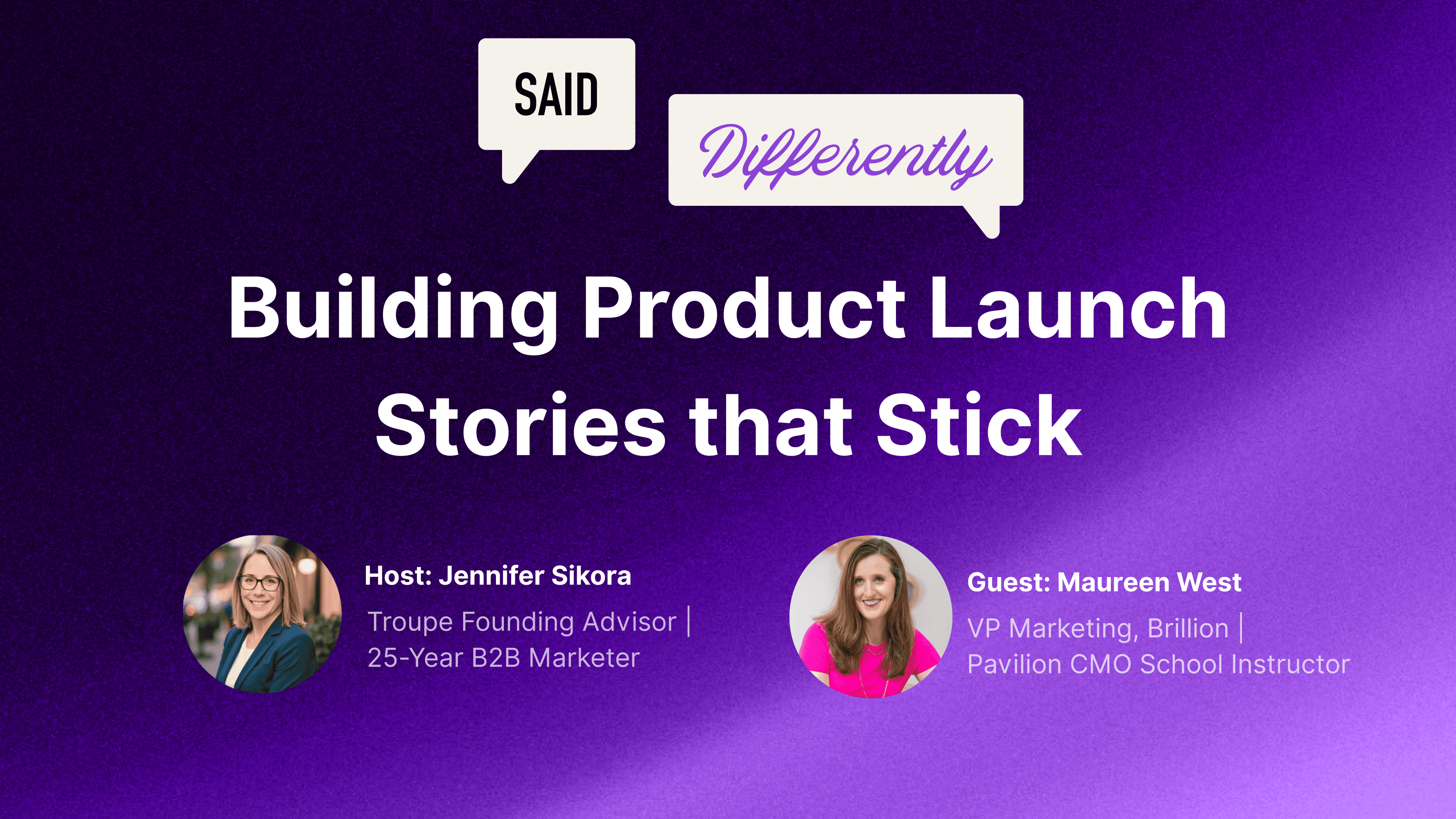

SAID DIFFERENTLY Ep.4: Building Product Launch Stories That Stick
When it's time to plot your product or feature launch, this conversation covers everything from defining your launch matrix to measuring messaging adoption and knowing when to stay quiet about competitors.
A lot rides on a successful product or feature launch. And even though launches vary by degrees of scope and impact, every launch should be accompanied by a strong, clear story that influences engagement and conversions.
In this episode of Said Differently, host Jennifer Sikora sat down with Maureen West, VP of Marketing at Brillion, whose career spans ExactTarget, Angi, and 6sense. Maureen teaches product marketing at Pavilion’s CMO School and has led launches while at startups to enterprise-level scale. Her take: successful launches aren’t about volume; they’re about orchestration and understanding messaging performance.
Matrix the Moment: Not Every Launch Is the Same
Maureen advises teams to categorize their launches early so that everyone knows their level of involvement, helps define a picture of the total effort, and helps set goals. “It is really important to categorize or classify your launch activity so that your organization knows how they should interact and respond,” she said.
New-product launches impact everything from pricing and invoicing to customer support and success. She adds a simple internal benchmark: “When you have a launch, your goal should be to have zero customers calling your support line because you did something without telling them.” Smaller feature updates? They can still matter, but need proportionate treatment.

Stakeholders Who Shape the Story
The story surrounding what you’re launching to the market shouldn’t live in a marketing silo. It means bringing together the right people across go-to-market teams who have a stake in the launch’s success and need to have their perspectives considered in the overall messaging plan. In addition to the head of marketing and product marketing, her launch table to help define the key messages includes:
- Product: to ensure the story is technically sound and accurate
- A copywriter: “not just AI, you must have a real-life person”
- Sales: “If sales doesn’t want to say it, you are sunk in the water”
- Customer Success: to help with retention and post-launch feedback
The cross-functional team, but particularly product marketing, must consider whether the new launch also impacts the overall market positioning for the company – is it adding to the existing product portfolio in a way that expands to new categories and/or to new buyer personas? This would suggest a larger body of messaging work that may expand the stakeholders at the table.
Before, During, and the 90 Days After
Whether it’s new or refreshed, a launch deserves runway. “Make your launch last at least one quarter. You need 90 days to really see how things are going.” She encourages teams to tie consecutive launches together so each new release extends the storyline instead of resetting it. And if you don’t have a net-new feature? Craft one by combining existing ones.
Host Jennifer Sikora describes a case where she identified several features that could be grouped together to tell a story that had real value to buyers and users. Maureen agreed: “Don’t be afraid to look back in your toolbox… you can actually create a bigger story around that.”
When the Message Misses
Sometimes your gut knows before the metrics do. “Do I feel confident about the story I’m telling? Because my gut has served me well for my career.” Early feedback, especially from sellers and what they’re hearing, matters most. Maureen builds a “brief deck” to test the message internally. “If the sales leaders aren’t on board, this is your litmus test… If they are, they’re already thinking about how their sellers can pick this up quickly.”
This is an opportunity to apply solutions like Troupe, where product marketers and sales enablement leaders can monitor adoption of new messages across the sales organization and in new content being generated, whether by humans and/or AI. Adoption can include components of frequency a new message is used and how well aligned it is with the target message meaning.
Competitor Launches: Respond or Resist?
Competitors are launching new offerings and features as well, so does that mean you should adjust your messaging accordingly? Maureen’s advice: don’t take the bait. “I personally don’t, and this is difficult for a lot of executive teams.” Instead of knee-jerk responses, she tracks signal frequency from sellers. “If your sales reps are saying, ‘I’m hearing so-and-so come up in deals,’ okay—how often is that?” If mentions rise, build objection-handling assets. Otherwise, stay focused.
“I would also double down on the value of our product and our messaging, instead of having a direct response.... At the end of the day, you have to feel good about the product you are putting into the market… and how you are helping your customers succeed.”